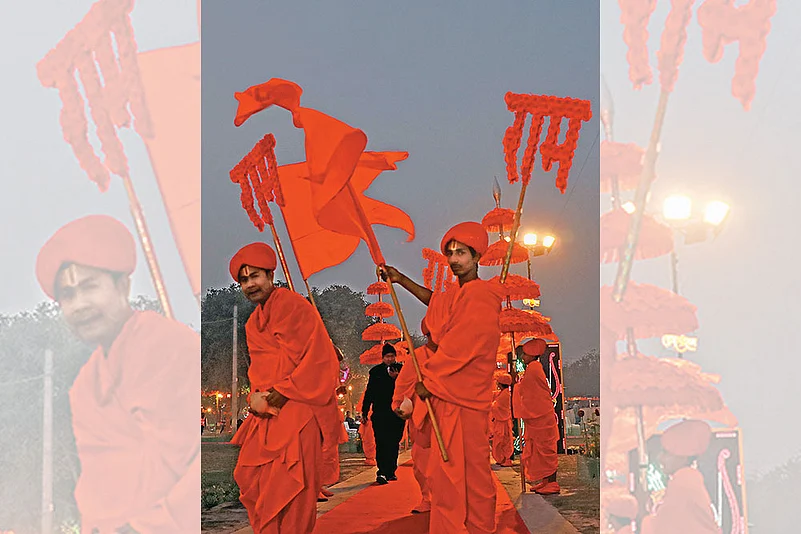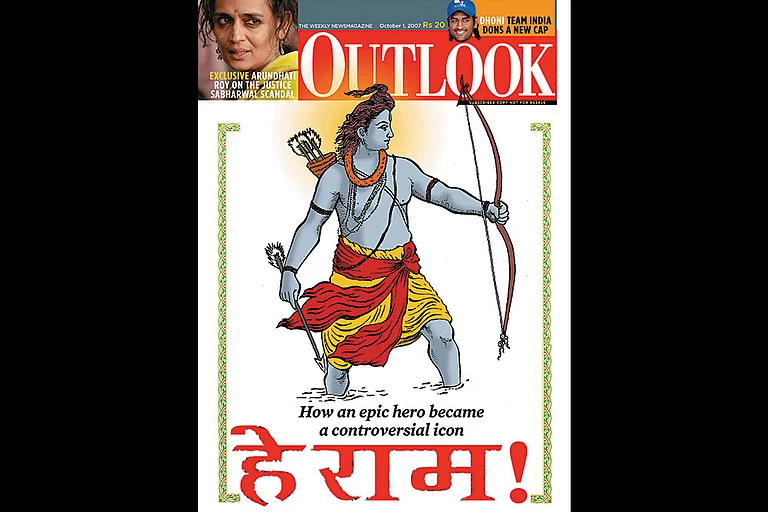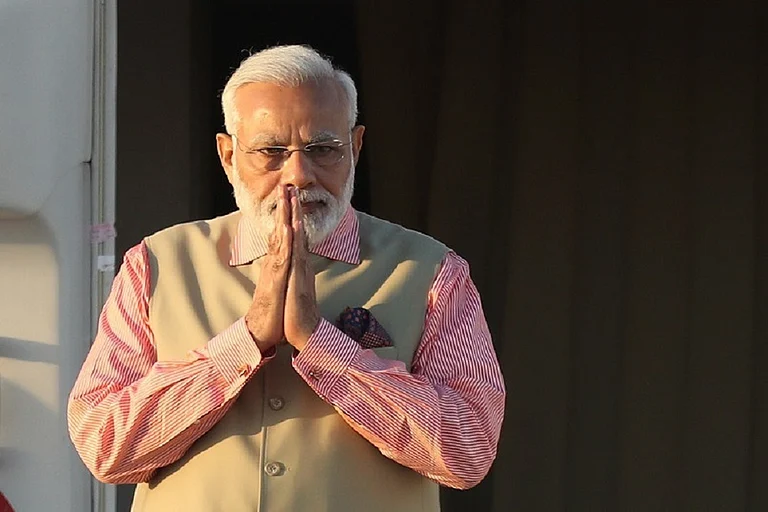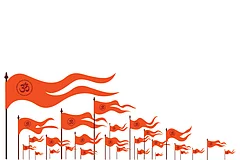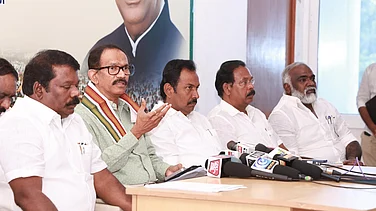In a certain outlying sylvan setting of some Ramnagar, Ramchandar hurled a daily greeting at his friend—“Ram, Ram, Ramkhilavan” to which came a quick reply—“Ram, Ram, Ramchandar!” And soon enough this enquiry into the wellbeing of each other transformed into a sense of daily duty. It had to, that is how it is. All of us living in India have been a witness to such a quotidian Ram. But what did they mean to communicate in this mirrored cultural alliteration and who is this Ram, and where is he? In many parts of India, the truth of Ram is invoked when carrying bodies to crematoriums i.e., in death is seen the truth of Ram and yet other times the victory to Ram is celebrated seeking hegemonic power for him. But whose Ram is he? In south Asia, Ram is a potent cultural trope—right from the poetic hero in the Ramayana of Valmiki to the popular hero of Tulsidas’s Ramcharitmanas, to the impersonated pure compassion of Bhavabhuti’s play Uttararamacarita, to Mullah Sa’dullah Panipati’s Muslim Ram in Masnavi-i Ram va Sita, to Kabir’s universal Ram and to sceptic philosopher Ram of the Maha-Ramayana, also known as the Yogavasistha, and all the way to the BJP’s political Ram. The Adhyatma-Ramayana hails Ram as a metaphysical reality (Brahman) while the poet-philosopher Allama Iqbal’s Ram is the ‘spiritual leader of India’ (Imam-e-Hind).
Unlike Valmiki’s Ramayana, the philosophical Ram of the Great Ramayana (Maha-Ramayana) sets on a pilgrimage as a teenager and emerges deeply introspective about the futility of life, exactly like the young prince Siddhartha (Buddha) once did, and broods concluding, “I do not belong to anyone. Nobody belongs to me. I will die like a lamp bereft of oil. After abandoning everything I will abandon this body”. Remember it is the Maha-Ramayana, the story of Ram’s metaphysical life. The exasperated Ram, a fresh sceptic, is perturbed by his own ignorance and seeks knowledge from his teacher Vasistha. He is an introspective and reflective Ram and this pilgrimage is an exercise of self-questioning. The dialogue begins and Vasistha appreciates the rational scepticism of Ram, saying: “Even the word of a child is accepted if it is in accordance with reason; otherwise the word of even the Brahma, the creator of the world, is to be abandoned like a piece of straw.” Ram begins questioning himself, seeking answers from Vasistha: “The knowledge of scriptures is a burden to the unwise and wisdom is a burden to one who is full of attachment; to one who is restless, his own mind is a burden; and to one who has no self-knowledge, the body is a burden. Though I am a hero, this craving makes me a frightened coward; though I have eyes to see, it makes me blind; though I am full of joy, it makes me miserable; it is like a dreadful goblin.” “I do not regard him as a hero who is able to battle successfully against a mighty army; only him I consider a hero who is able to cross the ocean known as the mind and the senses.” “Shame, shame upon those who are bound to this body, deluded by the wine of ignorance! Shame on those who are bound to this world!” (Translation by Venkatesananda)
Self-questioning is as if visiting Ayodhya and seeing Ram is like questioning the self. We are all Ram. Ram is that state of mind that compels us to introspect and retrospect. Our body is the Ayodhya, our mind the consecrated idol, and the spirit of questioning them is the pilgrimage that Ram of the Maha-Ramayana took. Like Ram, we do not want our mind and body to become a burden for us. Ram himself reflects—“the body without self-knowledge would be a dreadful goblin.” The philosopher Ram warns us—“don’t be deluded by ignorance and don’t be bound to the body.” Ironically ‘Ayodhya’ literally means that “cannot be warred against”—no war can take place there. The body cannot be warred against, the mind can.
Kabir celebrates the same Ram, a fourth Ram, as he says: “One Ram is the son of Dashrath, another Ram resides in the body of everyone, the third Ram is the one who manifests this cosmos, and the fourth is beyond all of them.” It is this fourth Ram of Kabir that is introspective—it is the Ram that is the value system that kills the immorality of intolerance, fanaticism, and inequality. Kabir insists upon us to “know the mind as Mecca, the heart as Dwarka, and the body as Kashi. Discover the Light within the cage with ten doors—the body”. Clearly, Kabir’s Ram was not in Ayodhya. Sadat Hasan Manto famously said: “The religion of an empty stomach is bread.” The Ram of the poor is bread and the Ram of the rich is privileged affluence. Can I visit an affluent temple with my stomach empty? It is this empty stomach that maps the metaphysics of a quotidian Ram. Shouldn’t the victory to Ram, the spiritual leader of India (Imam-e-Hind), mean the victory of this quotidian Ram?
We are warned by the forgotten teachings of Baba Bulleh Shah who reminds us about the art of self-reflective questioning, saying, “You have read and re-read and become a learned scholar, yet you never read yourself. You have repeatedly entered temples and mosques, yet you have never entered your own mind”. ‘Entering one’s own mind’ is the philosophical worship that the Ram of the Maha-Ramayana is engaged in and that is why he is a Maha-Ram, the contemplating Ram. He literally means ‘pleasing’, ‘delighting’, ‘rejoicing’ in Sanskrit just as quotidian Ram means aaram or ‘resting’ in oneself in Hindi or Urdu. He is pleasing and delightful to others.
We must contemplate before shooting a fatal arrow at the ‘wrongful’ Ravana next time—introspect and question ourselves like the philosopher Ram did—do we qualify to be righteous Ram assassinating Ravana? Executing Ravana is easy, introspecting is not. This is why we need a introspecting quotidian Ram.
So where is this Ram and who is he? In the powerful articulation of the Kannada poet Allama Prabhu: “Why another shrine when there’s one in the body? No one asked for two, My Lord. Goggeshvara, What am I, when you’re a stone?’. (Translation by Manu Devadevan) Allama is sarcastically provoking the god in the temple that is made in inert stone, saying that the god in the human body is dynamic since it can move. As opposed to this, the god in inert stone cannot even exercise its own power of freedom to move. Then, Allama asks, who is conscious and who is inert? Is the Ram in stone conscious or is the Ram in my body? So will our Ramchandar and Ramkhilavan of some Ramnagar replace “Ram, Ram” by “Jai Sri Ram” while enquiring about the wellbeing of each other? Will the quotidian Ram in our mind and body be replaced by the victorious powerful Ram outside in an inert stone house?
(Views expressed are personal)
(This appeared in the print as 'Who Is Ram vs Whose Ram?)
MORE FROM THIS ISSUE
Mrinal Kaul is a sanskrit scholar teaching indian philosophy at the Indian Institute Of Technology Bombay, Mumbai






